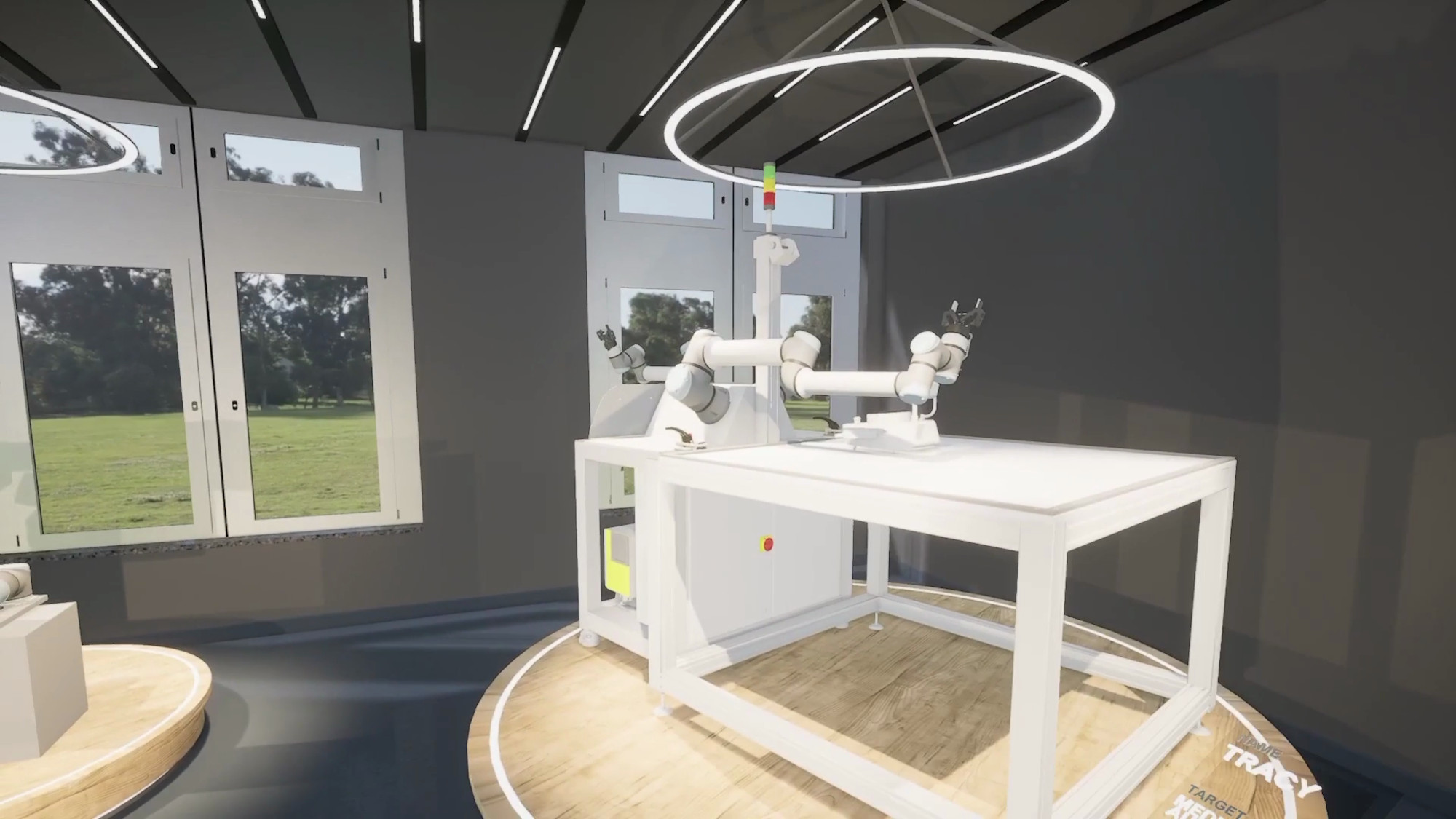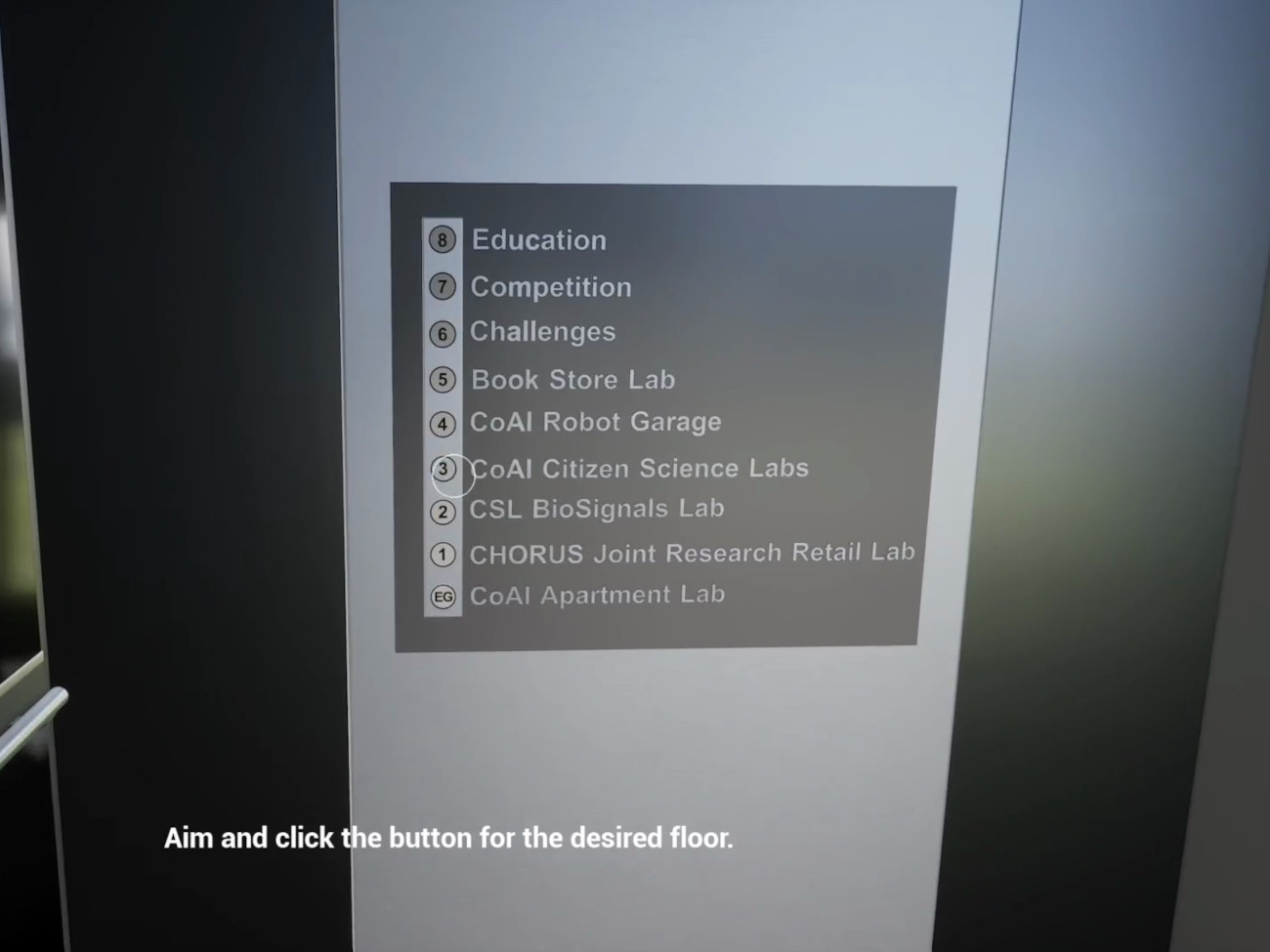Tall windows, a wide, bright hallway, a mirrored elevator: the virtual research building on cognitive-based AI can be entered like a location in a computer game which is waiting to be explored. Starting this year, five virtual floors will be available to both researchers and non-experts. The “Virtual Research and Training Building” (ViB) provides the opportunity to work with digital twins of household robots, play robot soccer, or learn about the role of robots in early childhood education. The goal of the virtual building is to present research on all facets of cognitive-based AI and bring together top international research in one place.
The Bremen Institute for Artificial Intelligence is implementing the idea of a virtual building for the Joint Research Center on Cooperative and Cognition-enabled AI (CoAI JRC) with partners from universities in Bielefeld, Bremen, and Paderborn. The CoAI JRC website already provides first glimpses of the new building. “Our joint successes and the complementary nature of our research is visible in this building,” says Dr. Hanna Voudouri, managing director of the high-profile area “Minds Media Machines” at the University of Bremen. Together with Dr. Brendan Balcerak Jackson from Bielefeld University and Dr. Stefanie Dick from Paderborn University, she is coordinating the construction of the building. Cognition-based artificial intelligence is the unifying theme in both the cooperation of the researchers and the ViB. The researchers’ approach is to enable robots to understand, similar to how humans do, why and what they are doing, to assess the consequences of their actions, to recognize their own mistakes, and to correct them independently. In order to achieve this goal, researchers use cooperative learning between humans and robots. The core concept for this is co-construction: robots and humans work together to gradually develop a common understanding of their tasks and their counterparts in order to learn new things.

© Institute for Artificial Intelligence
Building an Open Space for Everyone
“In our planning, it was particularly important that the building be accessible to everyone worldwide,” says Dr. Brendan Balcerak Jackson. This approach is propagated by numerous AI specialist societies and is now being implemented as a cutting-edge service, especially by researchers from cognitive robotics. One source of inspiration for this is the AI Roadmap of the Computing Community Consortium (CCC), an association of leading AI researchers from the USA. They give several reasons why open infrastructures are crucial in AI research. The researchers are convinced that services such as the ViB promote interdisciplinary exchange by engaging people who are not primarily researching AI. Additionally, students benefit from open infrastructures, since they quickly gain insights into current research. And finally, open platforms make research more efficient because research infrastructures are used worldwide and do not have to be set up separately at different locations. All of these aspects play a major role in the ViB.
Freely Accessible Laboratories for Researchers All over the World
The various rooms of the building are being created by researchers from Bielefeld, Bremen, and Paderborn and thus reflect their research topics. The core component of the building is the digital robot labs of the University of Bremen’s Institute for Artificial Intelligence (IAI). In these rooms, researchers worldwide have free access for experiments involving the digital twins of the Bremen household robots, together with the corresponding software. The close cooperation with international researchers across geographic boundaries that this makes possible is of critical importance to Michael Beetz, professor of artificial intelligence in Faculty 3 – Mathematics / Computer Science and head of the IAI. As a trailblazer in the field of open science, he has been making his research data and software freely available for many years. However, his goal is higher than establishing open access: “We are not just providing our infrastructure, but are also interested in contributions from the international research community,” he emphasizes. Specifically, this means that researchers from all over the world have the opportunity to create their own rooms in the virtual building. According to Beetz, especially in AI research groups, there is an enormous interest in making one’s own work openly available to the community and a broader audience.
Focusing on Interdisciplinary Work
The virtual environment should also contribute to the networking of researchers. “Just like in a physical building, there will be the possibility to look into different rooms and thus encounter new topics,” explains Dr. Hanna Voudouri. This is augmented by the fact that the participating researchers come from different disciplines.

© Institute for Artificial Intelligence
Research in the humanities and social sciences also takes place in the virtual building, such as in Paderborn University’s “Sprach-Spiel-Labor” (language development lab), which presents theoretical developments from psycholinguistics. Language learning is not only linked to actions, but also to dialogues. This connection from early childhood education is visualized here in many ways and serves as an inspiration for understanding the co-construction between humans and robots. Researchers from both Bremen and Bielefeld’s universities are also investigating how robots can learn new tasks or skills from humans in the “Co-Constructive Task Learning” project. Here, the researchers use virtual reality technology (VR) to demonstrate actions such as pouring water into a glass to the robots. From these demonstrations, virtual models are then created for the robots, which help them learn to perform the actions themselves. The goal for the future is to use this method in the ViB to teach robots these skills directly. A glimpse into the demonstrations and the memory logs of the robots is already freely available.
Reaching New Target Groups with Education and Competition Floors
The target audience for the building is not just researchers, but also students and interested laypersons. In order to reach as many people as possible, the technical access to the building is deliberately kept simple and most rooms should be accessible via a web browser without additional technical aids. The rooms are arranged by floors based on their target audience. The education floor, for example, is aimed specifically at students. Among other things, the “IntEL4CoRo” project is presented here, which enables students to learn the theoretical foundations of cognitive robotics and at the same time work on research with digital twins of robots. If you want to play games with robots, you have the opportunity to do so on the competition floor, where, for example, robots can play against each other in soccer matches. “In the end, we want to show that AI research is also fun,” says Dr. Stefanie Dick.




